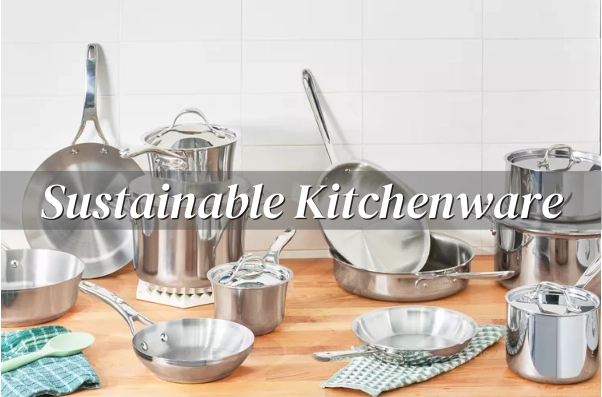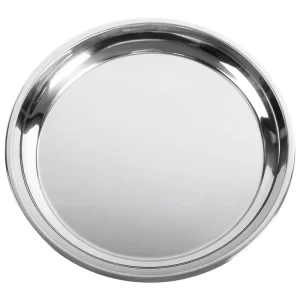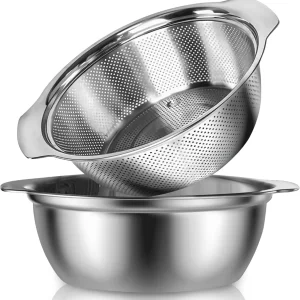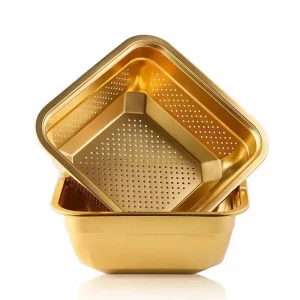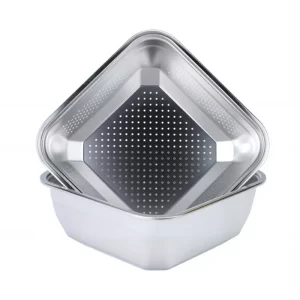На фоне того, что устойчивые закупки становятся глобальным консенсусом, все большее число предприятий, брендов общественного питания, платформ электронной коммерции и даже государственных учреждений активно переходят на более экологичные и низкоуглеродные системы цепочки поставок. В секторе кухни и общественного питания, который тесно связан с повседневной жизнью потребителей, выбор действительно экологически безопасных, надежных в эксплуатации и экономически эффективных продуктов стал ключевым фактором, который нельзя игнорировать при принятии решений о покупке. В настоящее время самая сложная проблема для покупателей заключается в том, как сбалансировать характеристики продукта и его экономическую эффективность. Давайте рассмотрим, как решить эту проблему.
Что такое экологически чистая и долговечная посуда?
Экологически чистые материалы - это материалы, которые оказывают меньшее воздействие на окружающую среду, потребляют меньше ресурсов и легче поддаются переработке, разложению или повторному использованию в течение всего жизненного цикла. Цель их использования - снижение загрязнения, экономия ресурсов и содействие устойчивому развитию.
Характеристики распространенных экологически чистых материалов
Нержавеющая сталь: 100% пригоден для вторичной переработки, прослужит более десяти лет, не содержит вредных веществ, экологически безопасен и долговечен
Стекло: Перерабатываемый, многоразовый, нетоксичный, подходит для контейнеров, контактирующих с пищевыми продуктами, но подвержен повреждениям
Бамбук/дерево: Производятся из возобновляемых ресурсов, биоразлагаемы, подходят только для одноразовых продуктов или продуктов кратковременного использования
Остатки сахарного тростника: Изготовленная из остатков, оставшихся после экстракции сока сахарного тростника, она является разлагаемой и компостируемой, и широко используется в экологичных обеденных тарелках, ланч-боксах и т.д. Он подходит только для одноразовой продукции или продукции кратковременного использования
PLA (полимолочная кислота): Растительная основа, промышленно компостируемая и разлагаемая, обычно используется в одноразовых изделиях, таких как соломинки и крышки для стаканов.
Материалы, изготовленные из целлюлозы и бумажных отходов: Разлагаемые и компостируемые, они часто используются для упаковки пищевых продуктов и подходят только для одноразовых или краткосрочных продуктов.
Исходя из вышеперечисленных материалов, мы пришли к выводу, что нержавеющая сталь является наиболее экологичной и долговечной.
Между тем, кухонная утварь из нержавеющей стали также является одной из самых популярных и развитых категорий на сегодняшний день, широко используемых в различных жизненных и коммерческих сценариях. Например, такие распространенные предметы, как миски, сервировочные тарелки, тазы, ложки, палочки для еды, вилки, контейнеры для хранения продуктов и т.д. Благодаря таким преимуществам, как экологичность, безопасность, долговечность и простота очистки, кухонная посуда из нержавеющей стали становится предпочтительным решением для все большего числа брендов общественного питания, платформ электронной коммерции и институциональных закупщиков при продвижении устойчивых закупок.
Характеристики кухонной посуды из нержавеющей стали
Будучи высокопроизводительным материалом с низкой нагрузкой на окружающую среду, она является одним из самых надежных материалов для достижения целей устойчивых закупок в настоящее время. Для покупателей, придающих большое значение долговечности продукции, безопасности и экологической ответственности бренда, выбор кухонной утвари из нержавеющей стали означает выбор долгосрочной устойчивой ценности. Ниже перечислены преимущества кухонной посуды из нержавеющей стали:
1.Он обладает сильной коррозионной стойкостью, прочностью и долгим сроком службы
Он содержит хром (обычно ≥10,5%), и на его поверхности может автоматически образовываться плотная пассивирующая пленка, эффективно предотвращающая окисление и ржавление.
Он обладает чрезвычайно сильными свойствами защиты от падения, давления и царапин, его нелегко сломать или деформировать, а срок его службы может достигать 5-10 лет или даже больше.
Значительное сокращение частоты замены и снижение долгосрочных затрат на закупку и эксплуатацию
2. Не содержит токсичных веществ и безопасен для контакта с пищевыми продуктами
Нержавеющая сталь - безопасный пищевой материал, не содержит BPA и тяжелых металлов, соответствует стандартам безопасности пищевых продуктов, таким как LFGB, FDA и CE.
Он не вступает в химическую реакцию с продуктами питания и подходит для различных ингредиентов, таких как кислые, жирные и соленые.
3. Устойчивость к высоким и низким температурам, подходит для различных способов приготовления пищи
Он может использоваться в среде с температурой выше 800°C без деформации и выделения вредных веществ
Он подходит для различных ситуаций, таких как открытый огонь, индукционные плиты, духовые шкафы, посудомоечные машины, холодильники и морозильные камеры.
4.100% можно перерабатывать, использовать повторно и не загрязнять окружающую среду
Нержавеющая сталь - экологически чистый металл, который можно перерабатывать и использовать повторно неограниченное количество раз
В процессе переработки не образуется никаких вредных веществ, при этом обеспечивается низкий углеродный след и высокая энергоэффективность
5. Легко чистится и совместим с современным кухонным оборудованием
Поверхность гладкая и чистая, не подвержена размножению бактерий, удобна для дезинфекции при высоких температурах и высоком давлении
Его можно применять в посудомоечных машинах, шкафах высокотемпературной дезинфекции и системах коммерческой уборки, что значительно снижает затраты на ручную уборку.
6. Он имеет широкий спектр применения, разнообразные стили и поддерживает кастомизацию
Его можно широко применять для посуды, мисок, тарелок, тазиков, палочек, ложек, вилок, ланч-боксов, термосов, подносов и т.д.
Применяется в различных сценариях, таких как семьи, рестораны, школы, больницы, столовые, сети быстрого питания и т.д.
Поддержка персонализации логотипов с помощью различных процессов, включая различные техники полировки (матовая, зеркальная, пескоструйная).
Как контролировать расходы?
1) Материал
В условиях контроля над расходами очень важно сделать разумный выбор материалов из нержавеющей стали. К распространенным материалам из нержавеющей стали относятся SS 410, SS 201, SS 304 и SS 316, каждый из которых имеет свои особенности в плане производительности и цены:
SS 410: Он имеет самую низкую цену, магнитится, обладает относительно высокой твердостью, но подвержен ржавчине. Он подходит для изделий с низкими требованиями к антикоррозионной стойкости.
SS 201: Он имеет умеренную стоимость, немагнитен и обладает средней коррозионной стойкостью. Он подходит для изделий, которые не вступают в прямой контакт с пищей, например, для подносов и стеллажей для инструментов.
SS 304: Она относится к пищевой нержавеющей стали, немагнитна и обладает отличной коррозионной стойкостью. Она широко используется в посуде, непосредственно контактирующей с пищей, и является основным выбором для кухонной утвари.
SS 316: Он имеет самую высокую цену и чрезвычайно сильную коррозионную стойкость. Он подходит для специальных сред, таких как высокая соль и высокая кислотность, и часто используется в медицинском оборудовании или элитной кухонной утвари.
При фактической закупке материалы должны быть выбраны разумно, исходя из области применения продукта, условий использования и бюджета. Не следует слепо гнаться за высокими марками, а лучше искать решения с наилучшими показателями стоимости, чтобы эффективно контролировать расходы, обеспечивая при этом эффективность продукции.
2) Толщина
Толщина кухонной посуды из нержавеющей стали не только определяет прочность и приятность изделия для рук, но и напрямую влияет на сложность его производства и стоимость изготовления. В реальном производстве соответствующая толщина должна выбираться с учетом высоты конструкции, сценариев применения и функциональных требований к изделию, чтобы контролировать расходы, обеспечивая при этом эксплуатационные характеристики.
Толщина: 0,4 мм - 0,5 мм
Он относится к легкой толщине и не подходит для изделий с большой высотой растяжения. Он подходит для изготовления кухонной посуды небольшого размера и малой глубины. Он широко используется в портативных контейнерах для хранения продуктов, плоских днищах, чашах для риса, кружках и других повседневных изделиях, и имеет такие преимущества, как низкая стоимость, простота формовки и удобство транспортировки.
Толщина: 0,6 мм - 0,8 мм
Он относится к средней толщине и может удовлетворить производственные требования средней и высокой глубины растяжения. Он больше подходит для изделий с определенными требованиями к прочности конструкции, таких как салатники, котелки, сковороды GN и т. д. Продукты этой толщины обеспечивают хороший баланс между долговечностью и стоимостью, что делает их основным выбором для коммерческого использования.
Толщина более 0,8 мм:
Он относится к конструкциям повышенной прочности и в основном используется для изделий с особыми требованиями к устойчивости к деформации, ударопрочности и стабильности конструкции, таких как промышленные бочки, большие кастрюли для супа, тяжелые обеденные тарелки или элитная кухонная посуда на заказ. Несмотря на более высокую стоимость, она подходит для высокоинтенсивных и высокочастотных условий эксплуатации и имеет более длительный срок службы.
В практическом применении оптимизация процесса (например, отбортовка, укрепляющие ребра, дизайн тиснения и т.д.) позволяет повысить прочность и структурную стабильность изделия без значительного увеличения толщины, что способствует дальнейшему снижению стоимости.
3) Поверхность
Обработка поверхности кухонной посуды из нержавеющей стали не только влияет на эстетический вид и ощущение от использования изделия, но и в определенной степени определяет его антикоррозийные характеристики и стоимость производства. Исходя из сценариев использования, позиции клиента и бюджета, выбор подходящего процесса обработки поверхности позволяет достичь комплексного баланса визуального эффекта, функциональности и стоимости.
Процесс полировки (шлифовка, полировка/зеркальная полировка)
Особенность: Яркая полировка делает поверхность блестящей. Чем она ярче, тем выше стоимость. Шлифовка и полировка придают поверхности высококлассную текстуру, а процесс шлифовки более дорогостоящий.
Применяется: сервировочные тарелки, кастрюли, ложки, чашки и т.д.
Предложение: Выбирайте тонкость полировки в зависимости от бюджета. Для изделий среднего и высокого ценового сегмента полировка требует более качественной текстуры. Для изделий с высокой стоимостью процесс полировки должен удовлетворять только обычным эстетическим требованиям.
2. Электролитическая обработка
Особенности: Поверхность обрабатывается электрохимическим способом, что делает ее более гладкой, устойчивой к коррозии и легко очищаемой.
Применяется для изделий медицинского класса или изделий с высокой степенью гигиены, таких как изолированные коробки, контейнеры для хранения продуктов, коммерческая посуда и т.д.
Предложение: Может использоваться для высококлассных продуктов, в которых важна функциональность, а не визуальные эффекты.
3. Гальванические процессы (титановое золото, черное гальваническое покрытие, цветное гальваническое покрытие)
Особенности: Декоративные цвета, такие как золотой, черный и розовое золото, повышают класс.
Применение: Подарочная посуда, элитная посуда на заказ.
Предложение: Стоимость значительно выше, чем у других процессов. Чем особеннее цвет и сложнее процесс, тем выше стоимость. При отсутствии особых требований выбор распространенных цветов будет более выгодным.
Повышение устойчивости и стоимости бренда
Многие покупатели ориентируются только на цену за единицу продукции и не обращают внимания на "возможность многократного использования" или "премиальность бренда". На европейском и американском рынках многие элитные бренды включили "металлическую посуду многоразового использования" в стандартную комплектацию. Потребители все больше признают устойчивые бренды, а продукция из нержавеющей стали в большей степени способствует созданию "зеленого" имиджа. Благодаря индивидуальным услугам (печать LOGO, лазерная гравировка и индивидуальная упаковка) посуда из нержавеющей стали также может способствовать продвижению бренда.
CONTACT US
Если вы ищете действительно экологичную и надежную нержавеющую сталь кухонная утварьМы искренне приветствуем вас в связаться с нами. Мы предложим вам профессиональную консультацию, индивидуальные решенияГарантии стабильных поставок для поддержки вашего пути "зеленых" преобразований.

